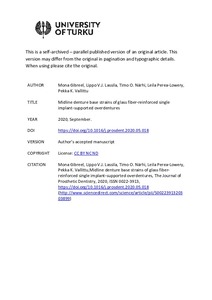Midline denture base strains of glass fiber-reinforced single implant-supported overdentures
Gibreel Mona; Närhi Timo O.; Vallittu Pekka K.; Lassila Lippo V. J.; Perea-Lowery Leila
https://urn.fi/URN:NBN:fi-fe2021042824441
Tiivistelmä
Statement of problem
The fracture incidence of implant-supported overdentures is more frequent in the area of attachment because of stress concentration and denture deformation in this area. How E-glass fiber reinforcement can address this problem is unclear.
Purpose
The purpose of this in vitro study was to evaluate the influence of unidirectional E-glass fiber reinforcement on the mid-line denture base strains of single implant-supported overdentures.
Material and methods
An experimental acrylic resin cast was constructed with a single implant placed in the mid-line area and a ball attachment screwed to the implant. Twenty-four experimental overdentures were constructed and divided into 4 groups: group AP fabricated from autopolymerizing acrylic resin without fiber reinforcement, group APF fabricated from autopolymerizing acrylic resin with unidirectional E-glass fiber reinforcement running over the residual ridge and the ball matrix, group HP fabricated from heat-polymerized acrylic resin without fiber reinforcement, and group HPF fabricated from heat-polymerized acrylic resin with unidirectional E-glass fiber reinforcement running over the residual ridge and the ball matrix. A biaxial rosette strain gauge was attached to the incisor areas of each overdenture above the attachment level (Ch1, Ch2) and to a multichannel digital strain meter. A static vertical load of 100 N was applied to the first molar area bilaterally by using a universal testing device during strain measurement procedures. The differences in the mean strain and deflection values among the investigated groups were evaluated for statistical significance using 1-way analysis of variance (ANOVA) with the Tukey post hoc multiple comparison (α=.05).
Results
The type of acrylic resin did not have a statistically significant effect on the mean strain values among groups (P=.350), while the reinforcement did significantly affect them (P<.001). The interaction between reinforcement and acrylic resin was not statistically significant (P=.552). Both strain gauge channels in group APF and group HPF recorded significantly lower strain values by almost 50% than those of group AP and group HP (P<.05).
Conclusions
Unidirectional E-glass fiber reinforcement placed over the residual ridge and implant attachment significantly reduced denture base strains and deformation of single implant-supported overdentures.
Kokoelmat
- Rinnakkaistallenteet [19207]
